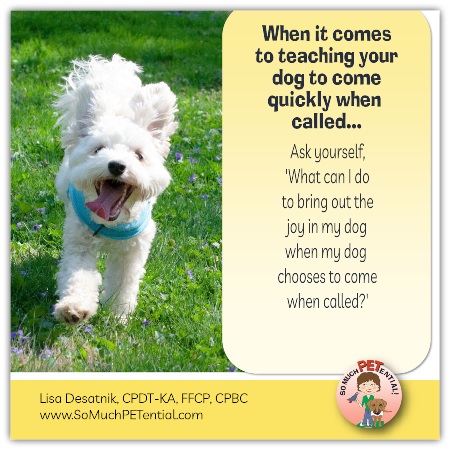If you want to teach your dog to come quickly when called (also called teaching your dog recall), it is important to ask yourself, “How can I make that choice the most awesome choice for my dog in that moment?” Remember, from your dog’s perspective, it’s all about consequences. Below I share some dog training tips to help you with the process.
 Just as with teaching any other behavior, having dog and puppy training success in training recall involves choosing the right learning environment and the right reinforcers for your pet, good timing in the delivery of marking the wanted behavior and reinforcing it, and progression in small or large enough steps that make the lesson plan engaging for your student and easy enough for success.
Just as with teaching any other behavior, having dog and puppy training success in training recall involves choosing the right learning environment and the right reinforcers for your pet, good timing in the delivery of marking the wanted behavior and reinforcing it, and progression in small or large enough steps that make the lesson plan engaging for your student and easy enough for success.
Recall is a skill that can be practiced every day. There are so many opportunities for building value for that choice to come. It is important that you give your dog great positive feedback that coming is worth every ounce of effort on his part. Puppies especially naturally already want to be by your side. What a fabulous time to reinforce them with valued food, play and/or attention!

There are so many strategies for teaching recall. In using any of them, these are some things to keep in mind:
- Always focus on setting you and your pet up for success. Do not try to call your dog when you know he will not come. Remember that every time you call him and he does anything but coming, you are weakening that cue and actually even teaching him a different meaning for the word come than what you had intended. ONLY call your dog when you can guarantee that at that moment, he will come when called.
- Just as in teaching any behavior, begin lessons in environments with minimum distractions and difficulty and only increase that as your dog can continue to succeed.
- Especially when you are first teaching this, always only call your dog to come when you can guarantee your dog a positive outcome. If you need your dog to come so that you can lock him in a room, give him a shot or something else unpleasant, this is NOT the time to be using your cue.
- If you have already weakened your recall cue, you may want to consider starting fresh with a new word or hand signal, and teaching that with absolute consistency.
- Have a good knowledge of your dog’s Awesome List and use high value items as consequences during training as you add to the level of difficulty. Remember, your dog is going to make decisions based upon choices. Stack the scale in favor of the choice you want him to make and mix up reinforcers so that you are unpredictable. It sure makes things fun.
- Practice. This is a behavior that you can work on throughout the day in short amounts of time.
- In addition to teaching your dog to come to you when you call, it is also a good idea to teach your dog that coming to you and having his collar touched and leash attached is a positive experience. If you are calling your escaped dog from a dangerous situation, that very well may be an important thing for your dog to know. Also practice teaching your dog to come and then asking for a stationary behavior like sit or drop (lay down). And follow that behavior with something your dog enjoys.

And, if you would like to teach your dog NOT to come when called, you may want to look at this blog post.






